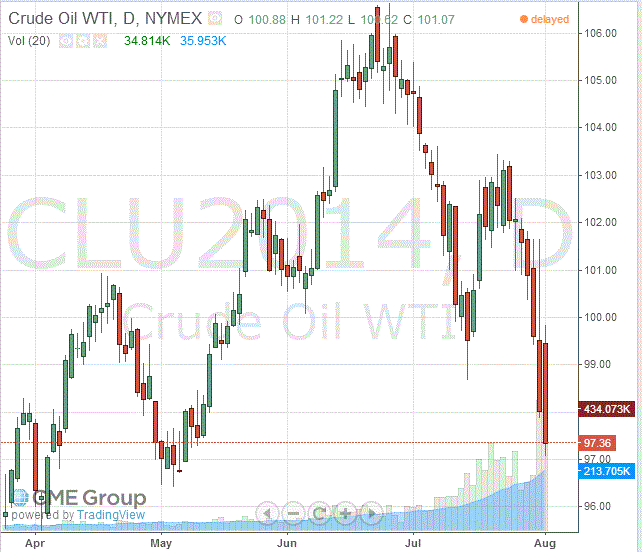Notícias do Mercado
-
16:40
Oil: an overview of the market situation
The price of oil fell moderately today, being at the same time near two-week low (grade Brent), as excess in the Atlantic basin and low demand outweighed concerns about tensions in the Middle East, North Africa and the Ukraine.
Experts point out that in spite of geopolitical risks, oil prices continue to fall. Neither situation in Iraq or a reduction in exports of Libyan oil or another military conflict between Israel and Hamas is unable to keep them from falling. It seems that speculators realized that almost all of these events will not reflect on the world oil market. According to forecasts, this year its production exceeds demand, so price drop seems logical.
The course of trade also influenced today's data on China, which showed activity indicators in the manufacturing sector in China in July rose, which was another sign of recovery in the sector. The official purchasing managers' index for the manufacturing of China in July rose to 51.7, its highest level in 27 months, against 51.0 in June, the National Bureau of Statistics reported. The July index was above economists' forecast - at 51.4. Subindex of manufacturing activity in small businesses in July rose to 50.1, surpassing the mark of 50 for the first time since April 2012. The new orders sub-index rose to 53.6, its highest level since May 2012. Meanwhile, according to HSBC Holdings PLC, the Purchasing Managers Index rose to 51.7 in July, its highest level in 18 months, against 50.7 in June. Nevertheless, the figure was lower than the preliminary assessment and the experts' forecasts - at the level of 52.0 points
Meanwhile, adding that a further fall in prices for oil futures today restrained today significant weakening of the U.S. dollar.
Market participants' attention is also drawn data and Thomson-Reuters Institute of Michigan, which showed that in July U.S. consumers feel more pessimistic about the economy than was recorded in the last month. According to the data, in July the final index of consumer sentiment fell to 81.8 compared with the final reading for June at 82.5 and the initial estimate for July at around 81.3. It is worth noting that, according to the average estimates of experts, the index was down compared with the June value to the level of 81.5.
The cost of the September futures on U.S. light crude oil WTI (Light Sweet Crude Oil) fell to $ 97.36 a barrel on the New York Mercantile Exchange (NYMEX).
September futures price for North Sea Brent crude oil mixture fell 97 cents to $ 104.82 a barrel on the London exchange ICE Futures Europe.
-
16:20
Gold: an overview of the market situation
Gold prices rose sharply today, departing from the six-week low, and almost completely offsetting the decline yesterday, which was associated with the release of weak data on the U.S. labor market, which led to slightly revise projections for changes in rates by the Federal Reserve.
The U.S. Labor Department said that the pace of hiring by American employers slowed in July but remained high, while employment growth was broad-based, indicating continued improvement in the labor market and the economy as a whole. Non-agricultural employment grew by a seasonally adjusted 209,000 last month. The unemployment rate, obtained by a separate survey of households, rose to a seasonally adjusted 6.2% in July from 6.1% in June. The unemployment rate fell by 1.1 percentage points from July 2013, when it was 7.3%. Economists had expected employment to increase by more 230,000 and the unemployment rate will remain at 6.1%. Employment rose by 298,000 in June, which was revised from earlier estimates of 288 000 and a gain in May was revised up to 229,000 from the earlier estimate of 224,000. Increase employment averaged 245,000 over the past three months, compared with an average of 209 000 for the 12 months ended in June.
Meanwhile, we add that the course of trade affects the weak demand for physical gold in Asia, despite the fall in prices on Thursday. Recall that China is a major contributor to the increase in demand for gold in the world. As reported by Reuters, the demand for gold jewelry in China in the second quarter of 2014 shows a decline for the first time in eight years. Experts expect that gold consumption in the country for the year could fall by 20% due to the weakening of the yuan and reduce the excitement of the gold market, which broke out in April last year, after a sharp fall in prices for precious metals.
"Currently, the Chinese do not rush to buy gold, because they believe that its value has decreased enough" - said Sarah Zhao, an analyst at Thomson Reuters GFMS. He also added that if the gold to continue to fall in price and fall below $ 1,200 per ounce, the buyers return to the market again.
It should be noted that since the beginning of the year, gold prices rose by 6.6 percent, but much of this success has been noted in the first quarter. By the end of June the price of the precious metal fell by 3.4 percent, while fixing the largest monthly decline since the beginning of 2014.
The cost of the August gold futures on the COMEX today rose $ 4.14 - to $ 1295.30 per ounce.
-

